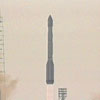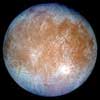|
Sunday:
June 17, 2001 | |
0251 GMT |
 |
XMM-Newton observatory peers into a stellar coffin
Astronomy is a painstaking discipline, requiring time and patience. Yet once in while, a string of discoveries using different telescopes occur in the same domain, each following hot on the heels of one another. Now, XMM-Newton adds the latest chapter to the story of IC443, one of the most studied supernova remnants.
 FULL STORY FULL STORY
 |  |

|
 |
Sprout wings and fly
Engineers at NASA's Dryden Flight Research Center have been flying a deployable, inflatable wing technology demonstrator experiment using a radio controlled airplane. The project's number one flight research question: "will it fly as the wings deploy in flight?"
 FULL STORY FULL STORY
 |  |

|
 |
|
Saturday:
June 16, 2001 | |
0940 GMT |
 |
Proton adds new craft to ASTRA satellite system
A new broadcasting spacecraft was propelled into Earth orbit on Saturday to join the ASTRA direct-to-home TV satellite system serving over 87 million homes across Europe.
 FULL STORY FULL STORY
 MISSION STATUS CENTER MISSION STATUS CENTER
 |  |

|
 |
Veteran space shuttle commander retires
Four-time space shuttle flier Brian Duffy (Col., USAF) has retired from the astronaut corps to accept a senior management position at Lockheed Martin. Duffy also will retire from the U.S. Air Force at the end of June.
 FULL STORY FULL STORY
 |  |

|
 |
Space technology improves view of giant telescope
NASA engineers in Alabama have been climbing a Texas mountain for the past year to help astronomers reach deeper into space with the world's third-largest telescope at the McDonald Observatory on Mount Fowlkes.
 FULL STORY FULL STORY
 |  |

|
 |
|
Friday:
June 15, 2001 | |
0452 GMT |
 |
Robot arm bumps into station, but passes key test
American astronauts aboard the international space station gave the outpost's new robotic arm a thorough workout on Thursday by successfully rehearsing the job of installing a 12-ton airlock during the next planned shuttle visit. But the test started off with the arm's free end striking the station.
 FULL STORY FULL STORY
 |  |

|
 |
Proton rocket nears liftoff
A new spacecraft for Europe's ASTRA direct-to-home TV and radio satellite system is ready to rocket into orbit aboard a commercial Russian Proton booster. Launch is planned for 0149 GMT Saturday (9:49 p.m. EDT Friday).
 MISSION STATUS CENTER MISSION STATUS CENTER
 |  |

|
 |
Hidden oceans on Europa could still support life
Could life thrive where the Sun never shines? The answer to this unorthodox question bears directly on the tantalizing possibility that life exists in the hidden, perpetually dark oceans that are thought to shroud some of Jupiter's moons, most prominently Europa.
 FULL STORY FULL STORY
 |  |

|
 |
Probe to take 'fingerprint' of comet nucleus
Instruments aboard a spacecraft that will be launched next year to explore two, and perhaps three or more, comets in the solar system will for the first time provide a "fingerprint" of the surface of cometary nuclei, giving the first firm evidence of the composition of the icy, rocky objects.
 FULL STORY FULL STORY
 |  |

|
 |
DAILY BRIEFING Other stories making news today
|
 |
Evidence suggests all radio-loud quasars may be blazars -- Researchers at The University of Texas at Austin have found new evidence to suggest that all radio-loud quasars may be blazars -- and the differences between them may be related to the angle from which they are viewed. Quasars are quasi-stellar objects found in distant reaches of the universe and blazars are much brighter types of quasars.
|
 |
|
Thursday:
June 14, 2001 | |
0533 GMT |
 |
Evidence found for recent shallow ground ice on Mars
New high-resolution images from Mars Global Surveyor show evidence of ground ice on Mars as recently as 10 million years ago. More striking is that the signs of geologically recent ground ice deposits are near the equator, where ice was probably no deeper than 15 feet.
 FULL STORY FULL STORY
 |  |

|
 |
Investigators prepare to OK next Pegasus rocket launch
NASA's $85 million HESSI mission designed to study solar flares could be launched next Thursday if engineers can finish their investigation to prove the satellite's ride to space -- an Orbital Sciences Pegasus rocket -- is fit to fly.
 FULL STORY FULL STORY
 BUY THE MISSION PATCH! BUY THE MISSION PATCH!
 |  |

|
 |
NASA selects first Mars scout concepts for study
The ten most promising mission concepts of the 43 proposed to NASA for possible launch to Mars in 2007 were selected Wednesday for continued studies. The missions include networks of small landers, orbiting constellations of small craft and a rover that would attempt to establish absolute surface ages of rocks and soils.
 FULL STORY FULL STORY
 |  |

|
 |
Brighter, redder Mars to illuminate summer nights
Hold on to your hats and keep a pair of binoculars handy: After a 26-month sprint around the track of the solar system, we are about to lap Mars again. The red planet is in "opposition," an event that puts Earth between Mars and the Sun. And next week, Mars will be at its closest distance from Earth since 1988.
 FULL STORY FULL STORY
 |  |

|
 |
|
Wednesday:
June 13, 2001 | |
0235 GMT |
 |
Repaired solar sail now ready for test launch
A suborbital demonstration flight of a solar sail is back on track for launch after a botched test damaged the craft. With repairs completed, the mission is expected to occur this summer aboard a Russian Volna rocket launched from a submarine in the Barents Sea.
 FULL STORY FULL STORY
 |  |

|
 |
New facility to improve airborne telescope's clarity
Images of space from NASA's SOFIA airborne observatory will be sharper and more precise, thanks to a new mirror coating facility that resembles a huge pressure cooker. The telescope's main mirror has to be periodically recoated.
 FULL STORY FULL STORY
 |  |

|
 |
DAILY BRIEFING Other stories making news today
|
 |
New study stirs old debate about galaxies -- Using a technique that peeks over obscuring rings of dust and gas and into the hearts of distant galaxies, a researcher has found evidence suggesting that as many as half of the bright, active galaxies known as Seyfert 2 galaxies may have significantly less active central black holes.
|
 |
|
Tuesday:
June 12, 2001 | |
0255 GMT |
 |
Jupiter's aurorae, volcanic eruptions on Io revealed
Impressive thermal-infrared images have been obtained of the giant planet Jupiter during tests at the Paranal Observatory in Chile. They show the full extent of the northern auroral ring and part of the southern aurora. A volcanic eruption was also imaged on Io, the very active inner Jovian moon.
 FULL STORY FULL STORY
 |  |

|
 |
Observations show brown dwarfs form like stars
An international team of astronomers has announced the discovery of dusty disks surrounding numerous very faint objects that are believed to be recently formed brown dwarfs in the Orion Nebula.
 FULL STORY FULL STORY
 |  |

|
 |
The 'ins and outs' of a celestial dance by Cluster 2
Europe's four Cluster spacecraft - Rumba, Salsa, Samba and Tango - are now dancing in a tetrahedron formation around the Earth. The quartet are ready to begin their first observations of the Earth's huge magnetic tail or magnetotail.
 FULL STORY FULL STORY
 |  |

|
 |
|
Monday:
June 11, 2001 | |
0220 GMT |
 |
X-ray nova, pulsating white dwarf found in Andromeda
In its first look at the Andromeda Galaxy, Europe's XMM satellite has revealed several unusual X-ray sources, including a bright spot created by an enormous X-ray nova outburst and one of the "coolest" sources of the central region that appears to be a luminous white dwarf.
 FULL STORY FULL STORY
 |  |

|
 |
Wind bubble found around young super star cluster
An international team of astronomers has detected a wind bubble associated with a super star cluster in a nearby galaxy -- a key indicator that helps explain how this extremely young cluster is evolving.
 FULL STORY FULL STORY
 |  |

|
 |
DAILY BRIEFING Other stories making news today
|
 |
Engineer brings cost of experiments down to Earth -- A Purdue University engineer is saving NASA millions of dollars by devising a method to test a new type of solar-power system on Earth instead of in the ultra-expensive environment of space.
|
 |


 The Hubble Space Telescope's majestic view of the Eskimo Nebula. This spectacular poster is available now from the Astronomy Now Store.
The Hubble Space Telescope's majestic view of the Eskimo Nebula. This spectacular poster is available now from the Astronomy Now Store.